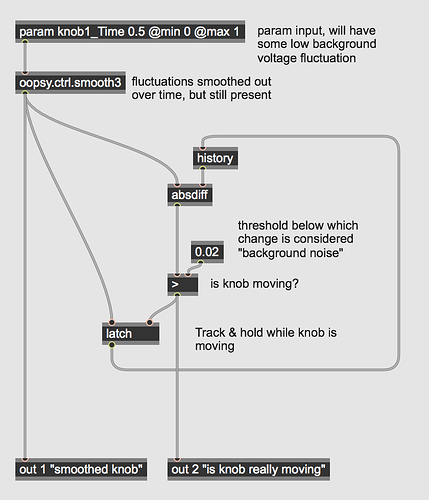Hi,
Im troubleshooting some apparent ‘noise’ on the Daisy Petal knobs within a Max 8 patch.
Basically im using a ‘change’ node to detect if a Knob has been changed and using the output to control a switch. Within Max it all look good but once flashed to the Daisy the test shows there are continual fluctuations on the Pot (knob1)
Using the below MaxPatch the change node (LED2 on the Petal) is detecting continual movement from the knob when flashed, even though its static.
I feel Im missing something really basic here?
Help would be appreciated.
AD
Some noise is to be expected. What’s the amplitude of the noise?
When you control a binary parameter with a noisy potentiometer, it may be useful to add a hysteresis to the response, e.g.
if lastValue == false && knob > 0.6
value = true
else if lastValue == true && knob < 0.4
value = false
Or phrased differently:
if lastValue == true
switchThreshold = 0.4
else
switchThreshold = 0.6
1 Like
“to detect if a Knob has been changed”
In Max, a param will hold an input value perfectly. E.g., 0.5 will always be 0.5 until you send a message to change it. In hardware, there is always some very small voltage fluctuations, so even if thte knob is positioned at 0.5, you will see a signal flow of something like 0.5001, 0.4995, 0.5012, 0.4989, etc. (really those numbers will have a lot more decimal places, but just to get the idea across). Since CV/knob inputs are sampled once per block, these little fluctuations will happen at whatever block rate you have – e.g. every 48 samples in your screenshot. Feeding this signal through [oopsy.ctrl.smooth3] will lowpass filter it, so you get very small, slow, but now continuously moving variation on the order of +/- 0.001. Your [change] object will pick up these fluctuations as real changes, even if they are very small, and continously output +1 and -1 accordingly.
If you want to know whether a knob was moved, you need to measure if the variation has exceeded a certain threshold; e.g. if the param value has changed by at least +/- 0.01 for example. For that, you need to know where it was since the last significant move. You can then use an [absdiff] to get the absolute difference, and if that is [> 0.01], then “knob is moving” is true. If “knob is moving” we need to update our reference value, which we can do using a [latch] (feed the smoothed signal into the left input, and the [> 0.01] to the right input). That [latch] can go back into the [absdiff] via a [history]:
And as @TheSlowGrowth says, if you want to usefully quantize the knob without having tiny fluctuations when the knob is right on the boundary between settings, you want to use hysteresis. A schmitt trigger is a common circuit for this:
Hope this helps!
3 Likes
Thanks grrrwaaa for your time,
The first idea worked perfectly. The pot movement sensing switch now works.
Much appreciation of your in depth replies.
Adrian



